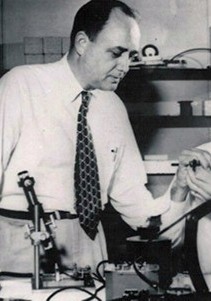-
(b.) -1907(d.)2003
Bio/Description
Born in South Dallas, Texas, he was Valedictorian at the Bryan Street High School in Dallas, Texas. He earned his undergraduate degree from Baylor University and a Doctorate in Physical Chemistry from Brown University in 1931. While at Brown, he began work in the laboratory of Professor Charles Kraus on the then useless element, germanium. He joined Bell Labs in 1930. He invented a method of applying the Czochralski method to produce extremely pure germanium single crystals used in making greatly improved transistors. He, together with Morgan Sparks invented a modification of the process that produced the configuration necessary for the fabrication of bipolar junction transistors. He is most remembered for developing the first silicon transistor while at Texas Instruments. When William Shockley's group at Bell Labs invented the transistor in 1947 he realized that substantial improvements in the device would result if it was fabricated using a single crystal, rather than the polycrystalline material then being used. He started a "boot-leg" project with very few resources or managerial support to make a simple crystal. In 1952 Dallas-based Texas Instruments had purchased a license to produce germanium transistors from Western Electric, the manufacturing arm of AT&T and placed an ad in the New York Times for a Director of Research. He, becoming homesick for his native Dallas, responded and was hired by Patrick E. Haggerty. He started at TI on January 1, 1953, bringing with him all his expertise in growing semiconductor crystals. Haggerty had hired him to establish a team of scientists and engineers to keep TI at the leading edge of the new and rapidly expanding semiconductor industry. His first assignment was to organize what became TI's Central Research Laboratories (CRL). Because of his background, this new department was modeled after Bell Labs. In April 1954 his TI CRL team created the first commercial silicon transistor and tested it on April 14, 1954. On May 10, 1954 at the Institute of Radio Engineers (IRE) National Conference on Airborne Electronics, in Dayton, Ohio, he revealed this achievement to the world when he announced, "Contrary to what my colleagues have told you about the bleak prospects for silicon transistors, I happen to have a few of them here in my pocket." He also presented a paper, "Some Recent Developments in Silicon and Germanium Materials and Devices," at this conference. He was hired to create and staff TI's CRL and was particularly proud of the outstanding talent recruited and developed as well as their subsequent impact on TI. In 1957 CRL developed a chemical reduction process for ultra-pure silicon. In 1958 a CRL employee, Jack Kilby, created the first integrated circuit. Other break-through developments include many advancements in infrared technology, and digital signal processing initially developed for the oil exploration industry, then for space and defense applications. During 1963 and 1964 he became the International Technical Director for TI, promoting TI's growth as an international company. He resided in England, France, and Italy and was most active in their scientific and industrial aspects. In 1965, he, taking a leave of absence from Texas Instruments, became the first Director of the National Bureau of Standards' Institute for Materials Research in Washington, D.C.
-
Date of Birth:
1907 -
Date of Death:
2003 -
Gender:
Male -
Noted For:
Developer of the first silicon transistor -
Category of Achievement:
-
More Info:


